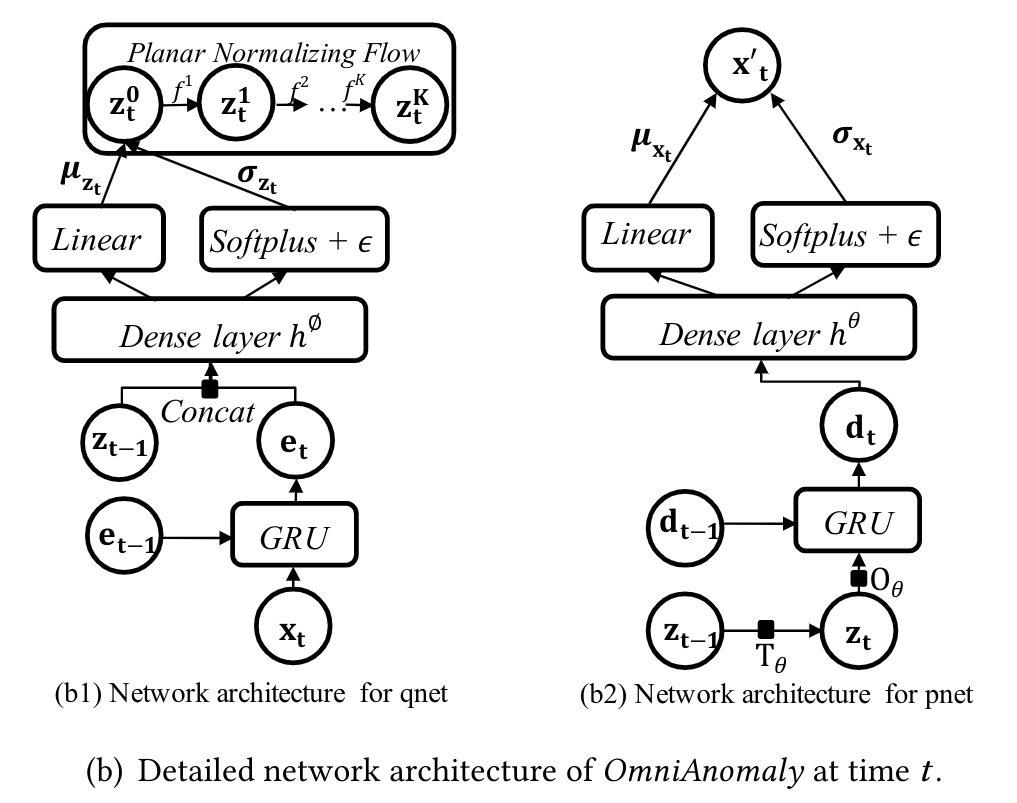PP: Robust Anomaly Detection for Multivariate Time Series through Stochastic Recurrent Neural Network
PROBLEM: OmniAnomaly
multivariate time series anomaly detection + unsupervised
主体思想: input: multivariate time series to RNN ------> capture the normal patterns -----> reconstruct input data by the representations ------> use the reconstruction probabilities to determine anomalies.
INTRODUCTION:
1. The first challenge is how to learn robust latent representations, considering both the temporal dependence and stochasticity of multivariate time series.
-------stochastic RNN + explicit temporal dependence among stochastic variables.
Stochastic variables are latent representations of input data and their quality is the key to model performance.
Their approach glues GRU and VAE with two key techniques:
- stochastic variable connection technique: explicitly model temporal dependence among stochastic variables in the latent space.
- Planar Normalizing Flows, which uses a series of invertible mappings可逆映射 to learn non-Gaussian posterior distributions in latent stochastic space.
2. The second challenge is how to provide interpretation to the detected entity-level anomalies, given the stochastic deep learning approaches.
Challenge: 1. capture long-term dependence. 2. capture probability distributions of multivariate time series. 3. how to interpret your results (unsupervised learning)
EVIDENCE: literature 5 shown that explicitly modeling the temporal dependence are better.
RELATED WORK:
PRELIMINARIES:
Problem statement: 以时序数据的个数作为维度,M个TS, x 属于R[M*N], x_t为一个M维的列向量,
gru, vae, and stochastic gradient variational bayes
DESIGN
OmniAnomaly structure: returns an anomaly score for x_t.
- online detection
- offline detection
- data preprocessing: data standardization, sequence segmentation through sliding windows T+1;
- input: multivariate time series inside a window, ----------Model training ------------output: an anomaly score for each observation ------- automatic threshold selection;

Detection: detect anomalies based on the reconstruction probability of x_t.
Loss function: ELBO;
Variational inference algorithms: SGVB;
Output: a univariate time series of anomaly scores
Automatic thresholds selection: extreme value theory + peaks-over-threshold;
1. use GRU to capture complex temporal dependence in x-space.
2. apply VAE to map observations to stochastic variables.
3. explicitly model temporal dependence among latent space, they propose the stochastic variable connection technique.
4. adopt planar NF.
Evaluation:
We use Precision, Recall, F1-Score (denoted as F1) to evaluate the performance of OmniAnomaly.
Baseline:
- LSTM with nonparametric dynamic thresholding
- EncDec-AD
- DAGMM
- LSTM-VAE
- Donut; 采取别的方式使donut适用于multivariate TS.
Supplementary knowledge:
1. VAE:
inference net qnet + generative net pnet.
2. GRU: gate recurrent unit
Reference
PP: Robust Anomaly Detection for Multivariate Time Series through Stochastic Recurrent Neural Network的更多相关文章
- PP: Unsupervised anomaly detection via variational auto-encoder for seasonal KPIs in web applications
Problem: unsupervised anomaly detection for seasonal KPIs in web applications. Donut: an unsupervise ...
- PP: A dual-stage attention-based recurrent neural network for time series prediction
Problem: time series prediction The nonlinear autoregressive exogenous model: The Nonlinear autoregr ...
- "Regressing Robust and Discriminative 3D Morphable Models with a very Deep Neural Network" 解读
简介:这是一篇17年的CVPR,作者提出使用现有的人脸识别深度神经网络Resnet101来得到一个具有鲁棒性的人脸模型. 原文链接:https://www.researchgate.net/publi ...
- Anomaly Detection for Time Series Data with Deep Learning——本质分类正常和异常的行为,对于检测异常行为,采用预测正常行为方式来做
A sample network anomaly detection project Suppose we wanted to detect network anomalies with the un ...
- Machine Learning No.10: Anomaly detection
1. Algorithm 2. evaluating an anomaly detection system 3. anomaly detection vs supervised learning 4 ...
- PP: Time series anomaly detection with variational autoencoders
Problem: unsupervised anomaly detection Model: VAE-reEncoder VAE with two encoders and one decoder. ...
- Time Series Anomaly Detection
这里有个2015年的综述文章,概括的比较好,各种技术的适用场景. https://iwringer.wordpress.com/2015/11/17/anomaly-detection-concep ...
- PP: Deep r -th Root of Rank Supervised Joint Binary Embedding for Multivariate Time Series Retrieval
from: Dacheng Tao 悉尼大学 PROBLEM: time series retrieval: given the current multivariate time series se ...
- PP: Toeplitz Inverse Covariance-Based Clustering of Multivariate Time Series Data
From: Stanford University; Jure Leskovec, citation 6w+; Problem: subsequence clustering. Challenging ...
随机推荐
- StarUML之五、StarUMl中Formatting Diagram-格式化图
这章比较简单,主要是对视图元素的样式调整 主要是在视图元素右下角设置,可以修改视图元素的相关样式 字体样式 颜色 链接线样式 对齐样式 Stereotype Display-视图元素的样式属性 菜单F ...
- everspin最新1Gb容量扩大MRAM吸引力
everspin提供了8/16-bit的DDR4-1333MT/s(667MHz)接口,但与较旧的基于DDR3的MRAM组件一样,时序上的差异使得其难以成为DRAM(动态随机存取器)的直接替代品. ...
- Linux_simpl shell-利用Shell脚本for循环输出系统中的用户及其Shell
[root@localhost ~]# vim user.sh 1 #!/bin/bash 2 for i in `cut -d ":" -f1 /etc/passwd`; 3 d ...
- OBS使用教程
OBS使用教程 OBS使用教程:录屏热键的设置 视频:基础画布分辨率1920/1080 1366,768输出缩放分辨率常用FPS值 30或者60 输出:输出模式:高级录像:编码器x264码率控制 CB ...
- Java基础之五、Java编程思想(1-7)
一.对象导论 1:多态的可互换对象 面向对象程序设计语言使用了后期绑定的概念. 当向对象发送消息时,被调用的代码直到运行时才能确定.也叫动态绑定. 2:单根继承结构 所有的类最终都继承自单一的基类,这 ...
- mysql必知必会--排序检索数据
排序数据 其实,检索出的数据并不是以纯粹的随机顺序显示的.如果不排 序,数据一般将以它在底层表中出现的顺序显示.这可以是数据最初 添加到表中的顺序.但是,如果数据后来进行过更新或删除,则此顺 序将会受 ...
- day18 正则表达式初学
正则规则:客观存在的,世界上任何一种语言都能使用它. 在线测试网址:http://tool.chinaz.com/regex 正则语句:只和字符串相关,需要考虑的是:在同一个位置上可以出现的字符范围 ...
- luogu P3369 【模板】普通平衡树
————————————————版权声明:本文为CSDN博主「ModestCoder_」的原创文章,遵循 CC 4.0 BY-SA 版权协议,转载请附上原文出处链接及本声明.原文链接:https:// ...
- 逆战:微信小程序开发(二)
一.常用组件 在上一个章节中讲解了封装请求数据的模块,在此处请求轮播图的数据 1.首页轮播图数据的请求以及渲染 1.1 轮播图数据的请求 pages/home/home.js import { req ...
- OpenCV学习记录(C++版本)
HighGUI组件 图像的载入:imread()函数 Mat imread(const string& filename, int flag = 1)其中flag=1代表读入RGB彩色图像,- ...
